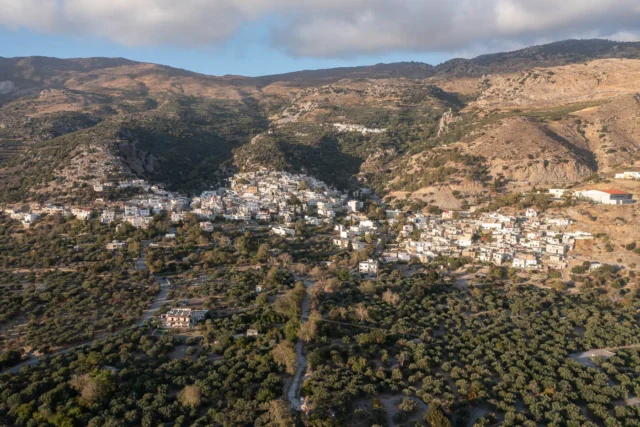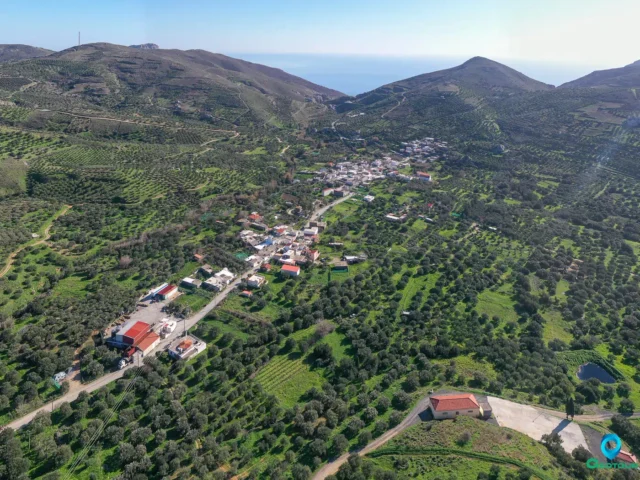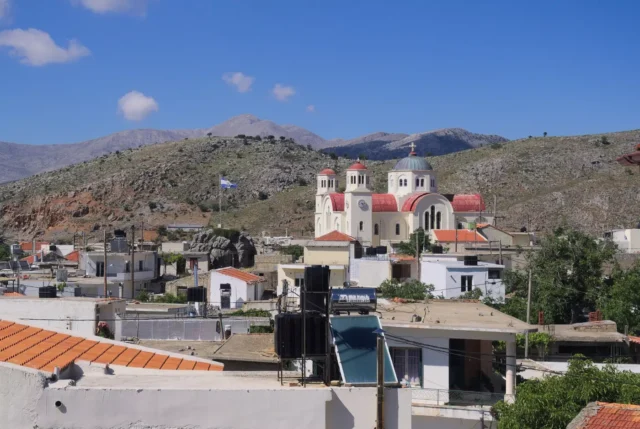Kato Symi (Κάτω Σύμη) is a village in the Viannos municipality in the Heraklion regional unit, Crete, Greece.
Geography
Kato Symi is located in a fertile valley surrounded by a wooded mountainous area, 770 meters above sea level. The village is 30 km from Ierapetra and 74 km from Heraklion. The area has the largest forest cover in the Heraklion regional unit, with the Symi forest being a continuation of the Selakano forest. The Blavopotamos river flows through the village, continuing towards Faflagko and ending in the Libyan Sea.
Economy
The main occupations of the residents are agriculture, livestock farming, and beekeeping. Early vegetables are grown in the coastal areas.
Religion
Kato Symi is the only community in Viannos that belongs ecclesiastically to the Holy Metropolis of Ierapetra and Sitia, as Symi was part of the former Municipality of Mournies, Lasithi. The nearby settlement of Ano Symi still belongs to the Community of Mournies, Ierapetra.
Natural Monuments and Attractions
The entire valley of Kato Symi is full of walnut, cherry, apricot, pear, and other fruit trees. Due to its mountainous nature, Symi has many caves, the most important being Zymbraga Spiliaria, Kissospilios, Leri cave, Boubouli cave, Riza cave, and Halavra cave. Another important natural monument in Kato Symi is the Kapnista Gorge, where, according to tradition, a giant man, Sarantapechos, lived.
The most important churches are the Church of the Panagia Galatoktismeni and Nistikoktismeni, the Church of Afenti Christou, the Church of Agios Ioannis Prodromos on the Ierapetra-Viannos road axis, and the Church of Agios Georgios. The first was built in 1385, as it is written on the lintel of the Holy Bema, and was named so because, according to tradition, the temple was built with mud and milk instead of water, by fasting craftsmen, throughout its construction. The church of Agios Georgios is located about 1 km outside the village, in the now uninhabited settlement of Apano Symi, which administratively belongs to the municipality of Ierapetra, at an altitude of 940 m, and has frescoes by Emmanuel Fokas, from1 the mid-15th century.
The most remarkable points of the village are Patela in Pano Geitonia and the location of Skepastou in Mesa Geitonia, where there is a water spring, the so-called Mesa Flega. The center of the village is in Karavos, where there is a square with an imposing plane tree. This is where the cafes and most of the village life are concentrated.
Archaeological Significance
The most important antiquities of Viannos are located in Kato Symi. It is the neo-palatial (Middle Minoan IIIb) sanctuary of Hermes and Aphrodite at the site of Krya Vrysi. The sanctuary is one of the most important of antiquity, as well as the only known place of worship to date in Crete and Greece that functioned for many centuries without interruption. It was founded around 2,000 BC. The location of the sanctuary is identified with Mount Hieron, according to Ptolemy, which is located between ancient Tsoutsouros and Ierapytna (modern Ierapetra). Worship at this site began in the Middle Minoan Era and continued until the Roman Imperial times. Findings from the sanctuary of Symi are now in the Archaeological Museum of Heraklion.
Historical Data
The village is mentioned in the census of the 1583 Castrophylaca with the name “Simi Catto” (K97) and with 146 inhabitants. During the period of Ottoman rule, some Turks lived there. In 1834 it had 38 Christian and 10 Turkish families, while Apano Symi was inhabited by 96 Christian families. In 1881 Kato Symi had 371 Christian inhabitants.
During2 the 1866 Revolution, two young women from Kato Symi, Maria Panakaki and Ergina Tsagkatopoula, while being chased by Turkish soldiers, fell like new Souliot women from the Gkoupo cliff, as they preferred to die rather than be dishonored.
In 1943, a German expeditionary force went to the village to punish the3 residents because they had killed two Germans at the Symi outpost. At the entrance to the valley, a well-fortified guerrilla force attacked the Germans on September 12, killing 84 and executing 12. Other sources report 70 dead on the German side. After this, the Nazis destroyed all the villages of eastern Viannos and western Ierapetra from the Myrtos river to the Amiras and shot all the male inhabitants (see Holocaust of Viannos).
Nikos Sygelakis or Chatzianagnostis or Symianos, a rebel before the Revolution of 1821, was born in Kato Symi in 1790. He was the terror of the Janissaries of Viannos.
Administrative Information
Apart from its seat, the Community of Kato Symi also includes the settlement of Loutraki. The 2011 census reports:
- Kato Symi (107)
- Loutraki (31)
In total, the community has 138 inhabitants.
The Municipal apartment of Kato Symi has a total population of 305 inhabitants. Apart from the seat, it includes the settlement of Loutraki, which has 66 inhabitants. In 1971 it had 45 inhabitants and is built at an altitude of 350 m. It is located 2 km from the sea and is4 the port of Kato Symi.
Settlement: Key Points
- Historical References: Mentioned in the 1583 census as “Simi Catto”
- Location: Viannos municipality, Heraklion regional unit, Crete, Greece.
- Historical Significance: Site of resistance during the Ottoman period and World War II. Rich in Minoan-era archaeological finds.
- Population Data:
Year |
Population |
Notes |
|---|---|---|
1881 |
371 |
Christians |
1900 |
313 |
|
1981 |
223 |
|
1991 |
221 |
|
2001 |
239 |
|
2011 |
107 |
|
2021 |
43 |
- Current Status: A small village with a declining population, known for its natural beauty and historical significance.
References
Access
Kato Symi is 3.8 kilometers away from Sykologos
































There are no comments yet.